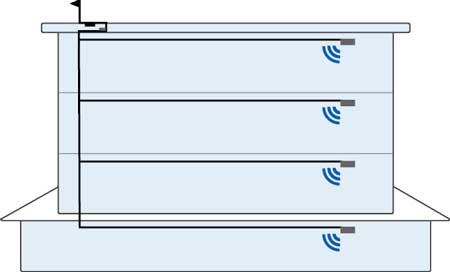Does your building require a Distributed Antenna System?
Why reliable radio connectivity in your building is critical to keeping occupants safe.

The events of September 11th, 2001 made the importance of reliable Public Safety communications very clear. First responders use two-way radios as their primary form of communication during disasters and emergencies, so reliable radio signal is essential for them to do their jobs safely and effectively. 
Inside the World Trade Center, police, fire, and EMS struggled to effectively communicate because of overload and weak signal, adding yet another challenge amidst the chaos. In response to this, new coverage requirements were set to ensure first responder radios work wherever they go. Having reliable coverage in all areas of a building can make the difference between life and death.
Why do some buildings lack radio connectivity?
There are several factors that hinder radio signal. These can be anything from the materials the building is made of to electrical equipment used in the building. As radio waves are transmitted from a nearby tower, these variables can impede the waves and prevent them from reaching certain areas. These same issues can be encountered when it comes to cellular signal, but for the purposes of this post, we’ll focus on radio communications.
How is radio coverage increased?
Technology makes it possible for radio signal to bypass the walls of a building altogether. Such technologies are referred to as In-Building Amplifiers or Distributed Antenna Systems (DAS systems).
How it works
Because radio frequencies struggle to pass through walls in a building, a rooftop antenna, referred to as a donor antenna, can be mounted to capture those frequencies. This antenna is placed in an ideal location and directed at the source of the radio signal (the nearby tower). It then pushes the signal to an amplifier, which is connected to a network of other antennas placed strategically throughout the structure. These smaller antennas take the signal and distribute it directly to the areas that need it. The antennas that work within the building are referred to as Bi-Directional Amplifiers (BDAs). A DAS system or BDA is usually tuned to Public Safety frequencies (700-900 MHz), but if building staff are also radio users, their frequencies can be added as well. This is a great option to further enhance the safety and efficiency of your team whether they use Motorola Solutions radios or another type.
How do I know if my building is code compliant?
During a building inspection — usually performed by the local Fire Marshal — radio connectivity is tested across the structure. If areas are found to have insufficient coverage, installation of an amplification system may be required. First responders depend on you to make sure your building meets radio coverage code, so becoming code-compliant should be a top priority.
The deployment process
Ensuring suitable coverage across all areas can be a complicated process, so it’s important to choose a provider with the experience and certifications to do the job properly. In order to gain an understanding of your building, the provider may perform a site visit, as well as request floor plans and wiring schematics. Then, they will customize the DAS system layout to suit each area. Installation time depends largely on the size and complexity of a building.
The good news is, Air Comm can handle the entire process — design to implementation. We’ll make sure you become compliant with all coverage standards and work with you to tailor your system to meet any additional needs.
Give us a call or contact us to schedule a site assessment.
Code Requirements
- International Fire Code (IFC) Section 510 requires building owners to provide acceptable Public Safety indoor radio coverage in new buildings. 95 percent in-building wireless signal coverage with a minimum signal strength of -95 dB.
- National Fire Protection Association (NFPA): NFPA 72 Chapter 24 code requires 90 percent in-building two-way radio signal coverage, & jumps to 99 percent for critical areas like fire pump rooms, exit stairs and passageways, and elevator lobbies.
- FCC13-21: Part 90 regulations describe requirements for signal boosters for Public Safety and private Land Mobile Radio (LMR) operations. Public safety DAS systems also need to be reliable under high heat and high humidity and function on a backup battery for 12 to 24 hours (depending on code requirements).
